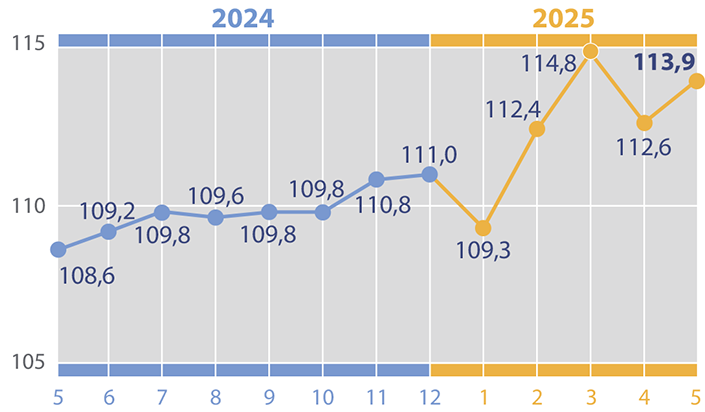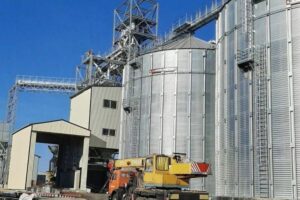
Employees of the State Bureau of Investigations (SBI) notified a Lviv businessman of their suspicions and detained the former chairman of the board of Ukrenergo on suspicion of fraudulent appropriation of funds from the state-owned enterprise EK Ukrenergo.
“Under the procedural guidance of the Office of the Prosecutor General, the SBI notified a Lviv businessman of suspicion and detained the former chairman of the board of Ukrenergo on suspicion of fraudulent appropriation of funds from NEC Ukrenergo,” the SBI reported on its Telegram channel on Tuesday.
“The scheme was organized by a Lviv businessman who had previously been exposed by the SBI for purchasing low-quality clothing for the needs of the Armed Forces of Ukraine for more than UAH 1 billion,” the agency said.
According to the bureau, in 2018, during tenders for the reconstruction of the external fencing of substations of the Southern and Western power systems, the official colluded with representatives of a private company.
At that time, as specified by the SBI, he held the position of deputy director for investments at the state-owned enterprise “NPC Ukrenergo.”
“Two contracts were signed between the parties for a total amount of over UAH 68 million. After that, the state-owned enterprise transferred over UAH 13.7 million in advance payments to the contractor, which the perpetrators embezzled,” the bureau said.
The SBI report does not name the individuals involved. They are former Ukrenergo head Volodymyr Kudrytskyi and Lviv businessman Ihor Hrynkevych.
Earlier, a source in law enforcement agencies told Interfax-Ukraine that SBI employees had detained former Ukrenergo head Volodymyr Kudrytskyi in the Lviv region and were preparing to charge him with fraud on an especially large scale.
The agency’s source specified that the case concerns businessman Ihor Hrynkevych and the alleged misappropriation of state-owned company funds during tenders for the reconstruction of power system facilities back in 2018.
After a nighttime incident in Podgorica, where a group of Turkish citizens stabbed a local resident during a conflict, the government of Milojko Spajić announced a temporary suspension of the visa-free regime for Turkish citizens—a political signal that security and entry controls take priority over previous openness (visa-free travel had been in place since 2008). The decision was confirmed by leading international media and government sources, which record both the incident itself and the authorities’ response formula—“a temporary pause + a rules review,” with the prospect of further consultations with Ankara on a new visa regime.
According to police reports, after a weekend marked by tension in the capital, several dozen foreigners—primarily citizens of Türkiye and Azerbaijan—were detained; President Jakov Milatović publicly called for calm and condemned retaliatory attacks on Turkish citizens and their property. This set of actions—stepped-up patrols, selective checks of legal stay, and preventive detentions—aligns with the logic of a “rapid stabilization” of order following stabbing incidents.
The socio-political backdrop has sharpened: anti-Turkish slogans were heard on the streets of Podgorica, and acts of vandalism were recorded—in particular, a business owned by a Turkish citizen in the city center was trashed, and a Turkish owner’s car was set on fire. These episodes heighten the risk of “collective responsibility,” when a single criminal offense triggers a chain of xenophobic reactions that harm people’s safety and the business climate.
The interstate dimension is developing in parallel: Türkiye’s foreign ministry promptly reached out to the Montenegrin prime minister and security officials, insisting on guarantees of rights and protection for Turkish citizens; Podgorica, for its part, declares “intensive consultations” with Ankara to find a model that combines public safety with continued economic interaction. This means that the “pause” in visa-free travel is not only a punitive gesture but also an instrument for reformatting access rules: new forms of short-term visas, mandatory registration procedures, or higher criteria for business visitors are possible.
The economic projection of the situation is ambiguous. Turkish business in Montenegro is a notable player in trade, hospitality, and real estate, especially along the Adriatic coast; rolling back visa-free travel will almost certainly reduce the mobility of entrepreneurs and workers, complicate seasonal planning, and slow transactional processes. Estimates of the size of the Turkish community vary: a number of sources cite roughly 13.3 thousand officially resident Turkish citizens (which is higher than the 2–3 thousand estimates mentioned in some materials), and for this group a clear, predictable procedure for extending stays and conducting business is crucial to avoid an outflow of investment and a “cooling” of employment in tourism and services.
At the domestic political level, the authorities’ decision serves several functions at once: it demonstrates control and sensitivity to the demand for security; cuts off the argument about “open gates” for offenders; and simultaneously mitigates reputational risks vis-à-vis the EU, with which Montenegro is negotiating membership, by aligning migration regimes and public-order standards with European practice. However, excessive “toughness” without simultaneously restraining xenophobia may provoke an escalation of ethnic tension and inflict long-term damage on the country’s investment image—this is precisely why the president’s message about the inadmissibility of attacks on Turks is a systemically important marker of balance.
From this follow the near-term scenarios. The first is “controlled thawing”: after stabilization and de-escalation of violence, and after technical parameters are agreed with Ankara, Podgorica restores simplified entry in an updated format (for example, through mandatory declarations of travel purpose or expedited category-based visas for investors and workers). The second is a “long pause”: the visa regime becomes entrenched, criteria for verifying the very purpose of entry and the legality of stay grow stricter, and Turkish companies’ business processes become costlier and slower, with a risk of investment being reallocated to neighboring jurisdictions. The third is “social turbulence”: if law-enforcement response to anti-Turkish pogroms is unsystematic, public sentiment will radicalize, and even a properly calibrated visa filter will not compensate for the loss of investor and tourist confidence. At present, government communications—about consultations with Türkiye and safeguarding public order—indicate that the bet is on the first, compromise path.
In summary, Montenegro’s decision to suspend visa-free travel is a system-level “alarm signal”: the authorities are simultaneously extinguishing a situational security crisis and trying to revise the architecture of migration procedures according to standards of control and predictability. However, the sustainability of this course will be determined not only by the strictness of border filters, but also by the state’s ability to protect lawful residents and entrepreneurs from collective punishment, hold perpetrators accountable, and preserve channels of economic cooperation with Türkiye—a partner that is already demanding security guarantees for its citizens and is ready to negotiate new rules of the game.
CRIME, INVESTMENTS, MONTENEGRO, PODGORICA, PUBLIC SENTIMENT, TURKEY
Import changes in % to previous period in 2024-2025

Source: Open4Business.com.ua

Elevator with a capacity of 40 thousand tons of storage is being built in Khmelnitsky region, reported the company “AktivProject” LLC, which is engaged in installation.
“In Khmelnitsky region the construction of another elevator continues. The customer decided to implement the project in full at once, without dividing it into queues,” the company wrote on its Facebook page.
The total storage capacity will be 40 thousand tons. The capacity of transport equipment is 100 tons/hour.
“The peculiarity of this facility is the installation of load cells on the shipping hopper, which will ensure accurate batching and simplify the process of loading grain into road transport,” – emphasized in “ActiveProject”.
OOO “AktivProject” specializes in complex design and installation of grain storage and processing facilities (elevators, feed, flour milling, oil extraction, grits plants), commodity warehouses and logistics complexes.

On October 21, the state enterprise Chuguevskyy Aircraft Repair Plant announced a tender for services of compulsory insurance of civil liability of owners of motor vehicles (OSAGO).
According to the website of the Ukrainian Universal Exchange, the expected cost of the service is UAH 188,487 thousand.
Documents are accepted until October 30.